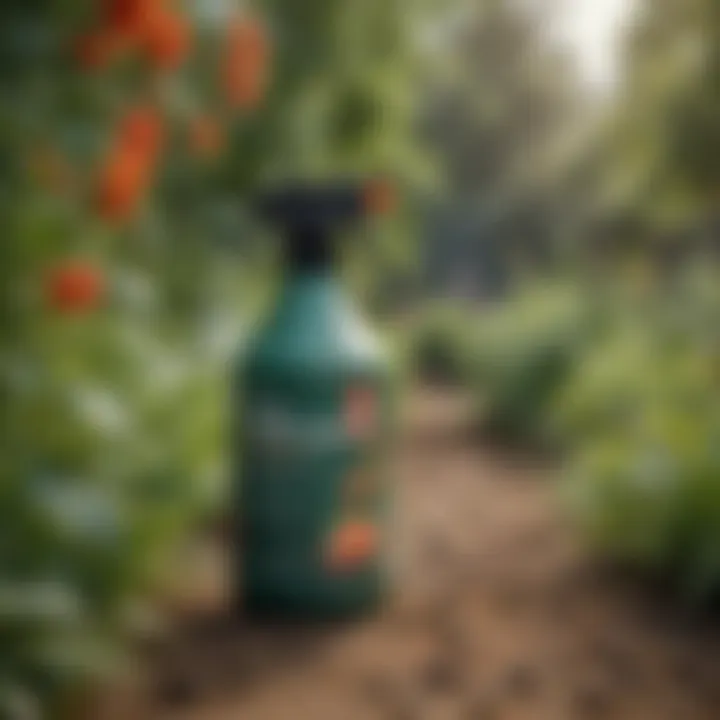Garden Fungicide Spray: A Comprehensive Overview


Intro
Garden fungicide sprays play a pivotal role in modern horticulture. Their importance cannot be overstated, given the alarming rise of fungal diseases affecting plants. These diseases compromise the health of crops and gardens alike, making fungicides essential for effective management. They help in safeguarding plants, ensuring healthy yields, and maintaining overall garden aesthetics. Understanding the nuances of garden fungicide sprays is vital for both novice and seasoned gardeners. This overview aims to elucidate their various types, application methods, active ingredients, and their overall impact on plant health.
Topic Overview
Definition and Importance
Fungicides are chemical compounds specifically designed to combat fungal infections. They inhibit the growth of fungi or eradicate them altogether. The importance of fungicides lies in their ability to protect plants from diseases such as powdery mildew, blight, and rust. These diseases can significantly reduce crop output and lead to the deterioration of plant quality.
Given the complexity of plant health, the use of fungicide sprays has become a common practice in gardening. Responsible use can lead to vibrant plant life and robust yields. Recognizing the correct application techniques and understanding how to integrate these products into a broader gardening regimen can further enhance results.
Brief History and Evolution
The use of fungicides can be traced back to ancient agricultural practices. Early farmers relied on natural substances like sulfur to manage fungal infections. As agricultural science advanced, so did the understanding of plant pathogens.
By the 20th century, synthetic fungicides were developed, offering more effective and targeted treatments. Over the decades, these chemicals have undergone significant evolution, improving their effectiveness while minimizing environmental impact. The development of systemic fungicides represented a major leap forward, allowing for deeper plant protection from within.
Key Techniques and Innovations
Sustainable Farming Practices
In recent years, there has been a push towards sustainable agriculture. Garden fungicides are no exception. Techniques like integrated pest management (IPM) combine chemical, biological, and cultural practices to manage diseases. Using fungicides as a part of IPM minimizes the reliance on chemicals alone. This method considers the whole ecosystem, ensuring that plant protection does not come at a high environmental cost.
- Crop Rotation: Changing what you plant in a particular area can reduce disease pressures.
- Resistant Varieties: Selecting plants bred for resistance to specific fungi reduces the need for fungicides.
Advanced Agronomic Technologies
Innovation in agriculture has led to the development of smart fungicide application technologies. Precision agriculture techniques allow for targeted spraying, maximizing treatment efficiency while reducing chemical usage.
- Drone Technology: Spraying fungicides with drones provides precision to areas that are difficult to reach.
- Soil Moisture Sensors: Monitoring soil conditions can help determine the optimal timing for fungicide applications.
Practical Applications
Step-by-Step Guides
Applying garden fungicide sprays effectively requires knowledge and careful planning. Here’s a simple guide:
- Identify the Problem: Determine the specific fungal disease affecting your plants.
- Select the Right Fungicide: Read labels carefully to ensure it is effective against your identified fungus.
- Prepare the Sprayer: Ensure your equipment is clean and functional.
- Mix Properly: Follow the manufacturer’s instructions for dilution and mixing.
- Apply Evenly: Spray during early morning or late afternoon to avoid sun damage and ensure even coverage.
- Monitor Plant Health: After application, observe the plants for response and adjust as necessary.
Case Studies or Real-World Examples
Various case studies illustrate the effective use of fungicides in gardens. For instance, a vegetable farmer faced persistent outbreaks of downy mildew. By integrating fungicides with cultural practices, such as increasing air circulation and selecting resistant varieties, the farmer reduced the incidence of the disease while saving on costs.
In another example, community gardens have adopted sustainable practices by implementing fungicides judiciously. This has led to healthier gardens and raised awareness about responsible fungicide use among gardeners.
"Effective fungicide use not only protects plants but also promotes overall garden vitality."
Through a well-rounded understanding of garden fungicides—complemented by sustainable practices—gardeners can better protect their plants while considering the environment. This balanced approach contributes to optimal garden health and addresses modern agricultural challenges.
Prelims to Garden Fungicide Sprays
Fungicide sprays play a crucial role in modern gardening and agriculture. These products protect plants from a variety of fungal diseases that can devastate crops and ornamental plants alike. Understanding fungicide sprays is essential for anyone involved in gardening, whether for aesthetic reasons or food production. This section introduces the concept of fungicide sprays and their significance in maintaining healthy plants.
Defining Fungicide Sprays
Fungicide sprays are chemicals designed to inhibit the growth of fungal pathogens. They can be used preventively or curatively, depending on the nature of the threat to the plants. The active ingredients in these sprays target specific fungi, disrupting their life cycles. Gardeners can choose from a wide range of formulations, including liquids, granules, and powders. It is essential that users understand the proper application methods to maximize efficacy while minimizing potential harm to surrounding flora and fauna.
The Importance of Fungicides in Gardening


Fungicides are vital to the success of any garden. They help to ensure the health and productivity of plants by controlling fungal diseases. Some common fungal diseases include powdery mildew, rust, and blight, which can severely impair plant growth and yield. By employing fungicide sprays, gardeners can mitigate these risks, leading to a more robust harvest and healthier plants overall.
"Effective management of fungal diseases requires a proactive approach, where fungicides serve as an important tool in any gardener's arsenal."
In addition to protecting individual plants, fungicides contribute to the overall balance of the garden ecosystem. Healthy plants can support beneficial organisms and deter pests that may otherwise thrive in a weakened environment. When used responsibly, fungicides not only safeguard crops but also promote a thriving garden environment.
Types of Garden Fungicide Sprays
Garden fungicide sprays are essential tools for maintaining plant health by combating fungal diseases. The various types of fungicides available can be broadly categorized into three main groups: synthetic, natural and organic, and biological fungicides. Understanding these types is vital for gardeners, as each brings unique benefits and considerations. This knowledge ensures the effective management of plant diseases while promoting responsible and sustainable gardening practices.
Synthetic Fungicides
Synthetic fungicides represent one of the most prevalent categories used in agricultural sectors. These products are chemically engineered to target specific fungal pathogens. Common active ingredients include azoles, chlorothalonil, and mancozeb. Their effectiveness is often immediate, which is an appealing feature for gardeners dealing with outbreaks of fungal diseases such as powdery mildew or root rot.
However, their use does come with some important considerations. Over-reliance on synthetic fungicides can lead to several issues. One significant concern is the development of resistance among fungal populations. This often necessitates higher doses or more potent chemicals, which can create a cyclic dependency on these products. Additionally, synthetic fungicides can pose risks to beneficial insects and the overall ecosystem.
Natural and Organic Fungicides
Natural and organic fungicides have gained popularity among those seeking more eco-friendly lawn care and gardening solutions. These types are derived from natural sources, including plant extracts and minerals. Neem oil, sulfur, and baking soda are frequently cited examples. They often work by enhancing the plant's natural defenses or inhibiting the growth of fungi in a gentler manner.
One of the significant advantages of organic fungicides is their lower environmental impact. Many are biodegradable, posing fewer risks to surrounding flora and fauna. Nevertheless, efficacy can sometimes vary based on environmental conditions and disease severity. Gardeners may find that while natural fungicides are generally safer, they might require more frequent applications or be less effective against severe infections.
Biological Fungicides
Biological fungicides leverage living organisms to combat fungal diseases. These include beneficial bacteria or fungi that outcompete or inhibit the growth of harmful pathogens. Notable examples are Trichoderma species and Bacillus subtilis. Biological fungicides work on the principles of biocontrol, which involve reducing disease incidence by enhancing soil health and microbiological activity.
Their appeal lies in their sustainable nature. By improving soil biodiversity, they not only help in disease management but also promote overall plant health and yield quality. Still, the challenge with biological options includes their sometimes slower onset of action when compared to synthetic products. Gardeners need to be patient with results while also ensuring optimal conditions for the biological agents to thrive.
Key Point: Each type of fungicide spray—synthetic, natural and organic, and biological—offers distinct advantages and drawbacks. Making an informed choice requires balancing effectiveness, environmental impact, and specific plant health needs.
Key Active Ingredients in Fungicides
Understanding the key active ingredients in fungicides is crucial for both effective application and ensuring plant health. These ingredients are the components that provide the fungicidal activity, targeting specific pathogens that threaten plants. Each active ingredient brings unique benefits and mechanisms of action, making them vital in combating fungal diseases. Their recognition helps gardeners choose the right product for their needs while considering efficacy, safety, and environmental impacts.
Chemical Compounds
Chemical compounds are among the most common active ingredients in fungicides. They often target the cellular processes of fungi, disrupting their lifecycle. For instance, compounds like azoles, such as Propiconazole, inhibit the synthesis of ergosterol, a critical component of fungal cell membranes. This disruption not only kills existing fungal cells but also prevents future growth.
However, while effective, reliance on chemical compounds can lead to resistance in some fungal strains. This resistance makes it imperative to use chemical fungicides judiciously, perhaps rotating between different classes of chemicals to minimize the risk of developing resistant fungi.
Plant Extracts
Plant extracts have gained popularity in recent years as a more sustainable alternative to synthetic fungicides. These extracts, derived from various plants, often possess fungicidal properties without the harsh effects associated with some chemical formulations. For example, neem oil, extracted from the seeds of the neem tree, not only acts as a fungicide but also deters insect pests.
The use of plant extracts aligns with organic gardening principles and can improve soil health. However, their variability in efficacy can pose challenges. It is important for gardeners to understand the specific active compounds in these extracts and how they interact with the target fungi. Proper identification and application are crucial to realizing their full benefits.
Microbial Agents
Microbial agents represent another fascinating class of active ingredients. These are living organisms, often beneficial bacteria or fungi, that can out-compete or parasitize harmful fungi. For instance, Trichoderma harzianum is a well-known microbial agent that can establish itself in the rhizosphere, thus preventing pathogenic fungi from taking hold.
The use of microbial agents offers a sustainable approach to managing fungal diseases. They can enhance soil health and promote plant growth. However, the conditions for their effectiveness need to be carefully managed. Factors such as soil temperature, moisture, and pH can influence their performance, necessitating a deeper understanding for effective application.
"The choice of active ingredients in fungicides should be informed by a comprehensive understanding of their mechanisms and potential impacts on both plant health and the environment."
In summary, the active ingredients in fungicides—whether chemical compounds, plant extracts, or microbial agents—play a pivotal role in managing fungal threats in the garden. Selecting the right ingredient, based on specific needs and environmental considerations, leads to successful plant protection and contributes to sustainable gardening practices.
Application Techniques for Fungicide Sprays
Application techniques for fungicide sprays are crucial for achieving optimal results in managing fungal diseases in the garden. The methods and timing of application can significantly influence the efficacy of the fungicide. Understanding these elements allows gardeners to minimize waste and environmental impact while maximizing plant health and productivity. Proper technique ensures that the fungicidal action reaches affected areas effectively, which is essential for controlling outbreaks and protecting plants.


Timing of Application
The timing of fungicide application is a key factor in its success. Applying fungicides at specific times can enhance their effectiveness. Generally, treatments are more beneficial when applied during the early stages of plant growth or at the first sign of disease symptoms. This approach targets fungal pathogens before they spread extensively. Different fungi have distinct growth patterns; knowing these patterns can guide the timing of applications, ensuring that the fungicide is utilized when it will be most effective.
Methods of Application
Spray Application
Spray application is a common and effective method for delivering fungicides to plants. The primary benefit of this technique is its ability to cover both the upper and lower leaf surfaces. A key characteristic of spray application is its versatility; it can be used on a variety of crops and target different fungal diseases. Typically, a fine mist is preferred for even distribution. This ensures that the fungicide can effectively penetrate the plant tissues.
However, spray application requires careful attention to timing and weather conditions. Windy conditions can cause drift, reducing the amount of fungicide that reaches the target. Additionally, applying fungicides during hot weather can lead to phytotoxicity. Thus, ensuring the right conditions is essential for maximizing the effectiveness of this application method.
Preventive Treatments
Preventive treatments involve applying fungicides before any signs of disease appear. This proactive approach is essential for managing common fungal issues. The key characteristic of preventive treatments is their focus on creating a protective barrier on plants. This barrier can deter pathogens from establishing themselves, thereby reducing the likelihood of plant infections.
The unique feature of preventive treatments is that they not only safeguard plants but can also be integrated into a regular care regimen. However, they should not be relied upon exclusively, as some fungi can bypass these barriers if environmental conditions are conducive to their growth. Combining preventive treatments with other gardening practices can yield better overall plant health and reduce the risk of severe infections.
"Proper timing and techniques in the application of fungicides significantly impact plant health and disease management."
Safety Considerations
When utilizing garden fungicide sprays, it is crucial to address safety considerations. These measures not only protect the individual applying the fungicides but also safeguard the environment and ensure the efficacy of pest management strategies. Knowledge about safe practices can lead to better outcomes in gardening while reducing unwanted risks.
Personal Protective Equipment (PPE)
Personal protective equipment (PPE) is vital for anyone involved in the application of fungicide sprays. PPE serves as a barrier against potential chemical exposure. Basic items include gloves, goggles, and masks. Wearing these items not only minimizes skin contact and inhalation of harmful substances but also promotes overall safety during gardening practices.
- Gloves: They protect hands from chemical burns and skin irritations. Choose chemical-resistant gloves for the best protection.
- Goggles: Eye protection is crucial, especially when spraying high-pressure applications. Ensure goggles fit well and are comfortable to wear.
- Masks: A mask can filter out harmful chemicals in the air. Select a mask rated for pesticide use to ensure adequate protection.
Taking the time to wear appropriate PPE can significantly reduce health risks associated with fungicide exposure.
Environmental Impact
The application of fungicides can have various effects on the environment. Understanding these impacts is essential for ensuring sustainable gardening. The selection and proper use of these products can minimize harm to non-target organisms. Here are some considerations:
- Water Contamination: Fungicides can leach into water sources if not applied correctly. It is important to avoid application before rainfall and to respect buffer zones around water bodies.
- Impact on Biodiversity: Some chemicals may harm beneficial insects and microorganisms. This can affect the ecosystem balance. Using targeted products and those with lower toxicity can help protect these organisms.
- Soil Health: Continuous use of certain fungicides can alter soil microbial communities. This may result in long-term consequences for plant growth. It is advisable to use integrated pest management strategies to reduce reliance on chemical treatments.
Integrated Pest Management (IPM)
Integrated Pest Management (IPM) offers a holistic approach to managing plant health. It prioritizes pest control while minimizing environmental effect. Implementing IPM in conjunction with fungicide use includes:
- Monitoring: Regular observation of plants for signs of fungal infection can help determine when fungicides are necessary. This tactic can prevent unnecessary applications.
- Cultural Practices: Techniques such as crop rotation, proper watering, and pruning can decrease fungal pressures naturally. These practices can also enhance plant resilience.
- Combination of Controls: When dealing with severe infestations, the combination of organic and synthetic fungicides can optimize effectiveness while being more environmentally sensitive.
Employing Integrated Pest Management can lead to healthier plants and a reduced need for chemical interventions.
Impact on Plant Health
Understanding the impact of garden fungicide sprays on plant health is essential for effective gardening. Fungicides play a critical role in managing fungal diseases that can devastate crops and ornamental plants alike. Their primary purpose is to control the proliferation of harmful fungi, thereby safeguarding the plants. When applied correctly, fungicides can significantly reduce disease symptoms and enhance the overall vigor of plants. They not only protect against existing infections but also prevent potential outbreaks, ensuring a healthier growing environment.
Efficacy Against Fungal Diseases
Fungicides are designed to combat a wide range of fungal infections. The efficacy of these sprays largely depends on the active ingredients they contain and how they are applied. A well-chosen fungicide can effectively target specific pathogens, such as Botrytis cinerea or Fusarium spp. By using the appropriate fungicide for the specific fungal disease, gardeners can see a marked improvement in the health of their plants. However, it is vital to follow recommended application rates and schedules to maximize effectiveness.
Potential Risks
While fungicides can provide substantial benefits, there are potential risks that must be understood.
Phytotoxicity


Phytotoxicity refers to the damage that fungicides can inflict on plants, sometimes leading to adverse effects rather than being beneficial. This may manifest as leaf burn, discoloration, or stunted growth. The key characteristic of phytotoxicity is its dependence on factors like concentration, the timing of application, and plant sensitivity. Therefore, it is crucial to conduct a small test on a few plants before widespread application. Understanding the unique aspects of phytotoxicity helps gardeners choose products that will not harm their plants while still providing the necessary protection against diseases.
Resistance Development
Resistance development is another significant concern when utilizing fungicides. Over time, fungi can evolve and adapt, becoming resistant to certain chemicals. This characteristic can lead to a decrease in the effectiveness of fungicides, forcing gardeners to switch to alternative methods or products. The unique feature of resistance development is its cumulative nature, arising from repeated use without proper management strategies. Sustainable practices, such as alternating fungicides with different modes of action, can help mitigate this risk, maintaining the efficacy of treatments while safeguarding plant health.
Implementing integrated pest management strategies can help reduce the reliance on fungicides and diminish the risk of resistance.
Sustainable Practices in Fungicide Use
The topic of sustainable practices in fungicide use is critical. As gardening becomes more popular, the importance of eco-friendly practices rises. Sustainable approaches help to maintain eficiency and reduce environmental impact. Understanding these practices can significantly benefit both gardeners and the ecosystem.
Choosing Eco-Friendly Options
Selecting eco-friendly fungicides is a significant first step. Natural or organic options can effectively combat fungal diseases, while also safeguarding the environment. Using products with plant extracts or microbial agents often reduces toxicity compared to synthetic alternatives. Organic fungicides can support soil health and encourage biodiversity.
Key eco-friendly options include:
- Neem Oil: Derived from the seeds of the neem tree, it is effective against various fungal pathogens.
- Bacillus subtilis: A beneficial bacterium that can outcompete harmful fungi.
- Potassium Bicarbonate: A natural compound that disrupts fungal cell membranes.
Prioritizing these alternatives can help gardeners protect their plants without compromising environmental safety.
Rotational Use of Different Fungicides
Employing a strategy of rotational use is advisable. This practice involves alternating fungicides with different active ingredients to prevent resistance development. Many fungi can adapt to constant exposure to the same chemicals, leading to reduced effectiveness over time.
Using a rotation plan, individuals can prolong the efficacy of their selected fungicides and manage fungal outbreaks more efficiently. Considerations for rotational use include:
- Assessing fungal resistance patterns: Knowing the local fungal issues helps in choosing the right fungicides.
- Following label recommendations: Some products suggest specific rotation schedules.
- Monitoring plant health: Keeping track of plant conditions assists in deciding when to switch products.
Implementing these sustainable practices can lead to healthier gardens while minimizing adverse effects on the environment. The benefits of responsible fungicide use extend beyond the immediate garden. They contribute to a more balanced ecosystem and promote long-term gardening success.
Future Trends in Fungicide Development
The field of fungicide development is evolving rapidly due to advances in technology and increasing awareness of environmental stewardship. Understanding the future trends in this area is crucial for gardeners and farmers who aim to balance effective plant protection with sustainability. Key areas of focus include organic formulations and innovative application techniques. These elements serve not only to enhance efficacy but also to minimize ecological impacts.
Advancements in Organic Formulations
As consumers demand more sustainable agricultural practices, advancements in organic formulations have gained traction. Organic fungicides utilize naturally-derived ingredients that can combat fungal diseases while posing less risk to the environment.
Products like neem oil and sulfur-based treatments have shown effectiveness against a range of plant pathogens. Scientists are now exploring new ways to enhance these formulations through improved extraction techniques and formulation methods. This ensures that organic fungicides can remain competitive with their synthetic counterparts, providing gardeners with efficient and eco-friendly options.
Moreover, research is being conducted on the synergistic effects of combining different natural compounds. For instance, formulations that include multiple plant extracts may demonstrate improved efficacy compared to single ingredients. This not only broadens the options for gardeners but also helps protect plant health across diverse environments.
Innovative Application Techniques
Alongside advancements in formulations, innovative application techniques are emerging as a pivotal trend in fungicide development. Technologies such as precision agriculture are transforming the way fungicides are applied to crops. Utilizing drones and automated sprayers allows for targeted applications, which reduces the amount of fungicide needed and minimizes environmental impact.
Furthermore, incorporating sensors that monitor plant health can guide the timing and dosage of fungicide applications. This data-driven approach means that fungicides are used only when necessary, improving efficacy and reducing waste.
"The integration of technology in fungicide application can redefine how we manage plant health and protect our crops."
In summary, as the agricultural landscape changes, attention to future trends like organic formulations and innovative application techniques will be essential. These advancements not only promote better plant health but also encourage responsible gardening practices.
Finale
The conclusion section serves as a critical point in summarizing the insights gained throughout the article. It encapsulates the essential elements regarding garden fungicide sprays, highlighting their significance in effective horticultural practices. Understanding the array of fungicides available, their applications, and the associated safety measures is paramount. It is also vital to acknowledge the balance between utilizing these chemical or biological agents and minimizing their environmental footprint.
Summarizing Key Points
In reviewing this comprehensive guide, the key takeaways are as follows:
- Defining Fungicides: Fungicides are essential tools in combating various fungal diseases that can devastate plant health. They can be synthetic, natural, or biological, each with its mode of action and specific benefits.
- Application Techniques: Timing and methods of application are crucial for maximizing the effectiveness of fungicide sprays. Correct application ensures that the plants are protected at the right time, preventing potential infections.
- Safety and Sustainability: Prioritizing personal protective equipment and understanding the environmental implications of fungicides cannot be overstated. Utilizing them within an integrated pest management system promotes responsible use while achieving optimal plant health.
- Future Trends: The development of eco-friendly formulations and innovative application techniques represents a promising direction for sustainable gardening practices.
Final Thoughts on Responsible Use
As the world increasingly values sustainable agriculture, responsible use of fungicides becomes essential. It is imperative for both novice and experienced gardeners to understand the potential risks alongside the benefits. This includes recognizing the possibility of resistance development, phytotoxicity, and selecting appropriate fungicides that align with ecological values.
The path forward requires a conscious choice towards eco-friendly products and practices. By embracing sustainability, gardeners can protect their plants and, at the same time, contribute to a healthier environment. Ultimately, the knowledge shared in this article empowers individuals to make informed decisions, ensuring that their gardening endeavors thrive while safeguarding the planet.



